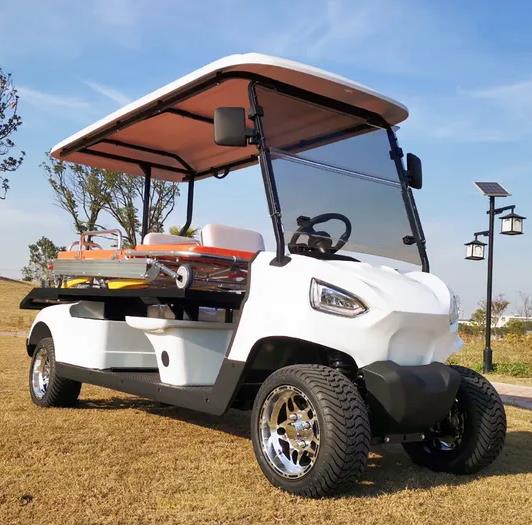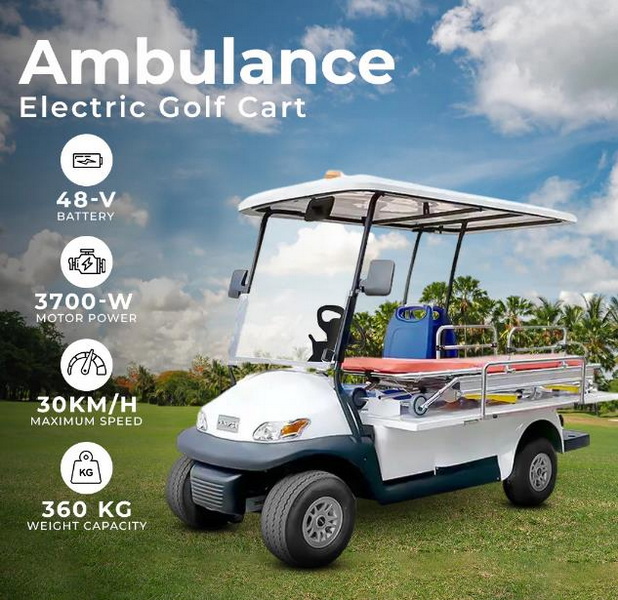Content Menu
● Introduction to Electric Ambulance Carts
● Maintenance Tips for Electric Ambulance Carts
>> 1. Battery Maintenance
>> 2. Brake Maintenance
>> 3. Software Updates
>> 4. Tire Maintenance
>> 5. Body and Chassis Maintenance
● Additional Tips for Electric Ambulance Carts
>> Long-Term Storage
>> Routine Inspections
>> Electrical System Checks
>> Interior Maintenance
● Specialized Maintenance for Electric Ambulance Carts
>> Customized Maintenance Plans
>> Training for Technicians
● Conclusion
● FAQ
>> 1. What is the recommended charging practice for electric ambulance carts?
>> 2. How often should brake inspections be performed on electric ambulance carts?
>> 3. What is the importance of software updates for electric ambulance carts?
>> 4. How can I prevent tire wear on electric ambulance carts?
>> 5. What steps should be taken before storing an electric ambulance cart for an extended period?
As the world shifts towards more sustainable and environmentally friendly transportation options, electric vehicles are becoming increasingly popular. This trend is also evident in specialized vehicles like ambulances, where electric models are being introduced to reduce emissions and enhance efficiency. Electric ambulance carts, designed for specific medical transport needs, require regular maintenance to ensure optimal performance and safety. Here, we will explore the top maintenance tips for these vehicles, focusing on battery care, brake maintenance, software updates, and other essential checks.

Introduction to Electric Ambulance Carts
Electric ambulance carts are designed to provide efficient and quiet transportation for medical emergencies. They are equipped with advanced technology to support patient care and are built to navigate through crowded urban environments with ease. The Demers eFX ambulance, for example, is a Type III all-electric ambulance that integrates seamlessly with the Lion5 chassis, offering a spacious patient compartment and advanced ergonomic features for first responders.
Maintenance Tips for Electric Ambulance Carts
1. Battery Maintenance
The battery is the heart of any electric vehicle, including electric ambulance carts. Proper battery care is crucial for extending the lifespan and ensuring reliable performance.
- Charging Practices: Avoid consistently charging the battery to 100% or letting it drain to 0%. Most manufacturers recommend keeping the battery between 20-80% for daily use to prolong its lifespan. This practice helps reduce stress on the battery cells and prevents overheating, which can lead to premature degradation.
- Temperature Control: Extreme temperatures can negatively impact battery performance. Ensure that the vehicle is parked in a shaded area or a climate-controlled environment when possible. High temperatures can accelerate chemical reactions within the battery, reducing its capacity over time.
- Regular Inspections: Schedule periodic battery inspections with a qualified technician to assess its health and identify any potential issues. These inspections can help detect early signs of degradation, such as uneven cell voltage or increased internal resistance.
2. Brake Maintenance
Electric vehicles utilize regenerative braking, which reduces wear on brake pads and rotors. However, traditional friction brakes are still necessary for complete stops and emergency situations.
- Regular Checks: Inspect brake pads, rotors, and fluid regularly. Look for signs of wear, such as squeaking or grinding noises. Although regenerative braking reduces wear, it's essential to ensure that the friction brakes are in good condition for when they are needed.
- Maintenance Schedule: Perform brake inspections every 18 months or sooner if the vehicle is used frequently. This schedule helps maintain safety and prevents unexpected failures during critical operations.
3. Software Updates
Electric vehicles rely on sophisticated software for operation. Regular updates can improve performance, safety, and efficiency.
- Automatic Updates: Many vehicles update software automatically, but it's essential to ensure your vehicle is connected to the internet or check with the manufacturer for manual updates. These updates often include bug fixes, security patches, and enhancements to vehicle systems.
- Manufacturer Guidelines: Follow the manufacturer's recommendations for software updates to avoid compatibility issues. Improper updates can lead to system malfunctions or even render the vehicle inoperable.
4. Tire Maintenance
Electric vehicles are heavier than their combustion engine counterparts, which can lead to faster tire wear.
- Pressure Checks: Regularly check tire pressure and ensure it matches the manufacturer's recommendations. Proper inflation can improve handling, reduce wear, and enhance safety.
- Wheel Alignment: Perform professional wheel alignments annually or more frequently if driving on rough roads. Misaligned wheels can lead to uneven tire wear and affect vehicle stability.
5. Body and Chassis Maintenance
Regular cleaning and inspections can prevent damage from environmental factors.
- Cleaning: Wash the vehicle regularly to protect the body from road salts and other corrosive substances. Use mild detergents and avoid high-pressure washes that could damage electrical components.
- Inspections: Check for any scratches or dents and repair them promptly to maintain the vehicle's integrity. Small damages can lead to rust or water intrusion if not addressed.

Additional Tips for Electric Ambulance Carts
Long-Term Storage
If the vehicle will not be used for an extended period, follow these steps:
- Battery Care: Charge the battery to full capacity before storage and disconnect it to prevent self-discharge. This helps maintain battery health and prevents deep discharge, which can cause irreversible damage.
- Tire Pressure: Inflate tires to the recommended pressure to prevent flat spots. Underinflated tires can develop uneven wear patterns or become damaged during storage.
- Cleanliness: Ensure the vehicle is clean and free of debris to prevent damage during storage. Remove any accessories or equipment that could cause scratches or dents.
Routine Inspections
Regular inspections can help identify potential issues before they become major problems.
- Terminal Checks: Clean battery terminals regularly using a baking soda and water solution to prevent corrosion. Corrosion can disrupt electrical connections and lead to system failures.
- Cable Checks: Ensure all cables are secure and not damaged. Damaged cables can cause electrical malfunctions or safety hazards.
Electrical System Checks
- Lighting and Signals: Verify that all exterior lights, including emergency lights, are functioning correctly. Malfunctioning lights can compromise visibility and safety during operations.
- Communication Equipment: Test communication systems regularly to ensure they are working properly. This includes radios, sirens, and other critical communication tools.
Interior Maintenance
- Sanitization: Regularly sanitize the interior to maintain a clean environment for patients. Use appropriate disinfectants and follow guidelines for infection control.
- Equipment Checks: Ensure all medical equipment is in working order and properly secured. Regularly inspect stretchers, oxygen tanks, and other life-saving devices.
Specialized Maintenance for Electric Ambulance Carts
Customized Maintenance Plans
Develop a customized maintenance plan based on the vehicle's usage and environment. This might include more frequent checks for vehicles used in harsh conditions or high-mileage scenarios.
Training for Technicians
Ensure that maintenance technicians are trained specifically on electric ambulance carts. They should be familiar with the unique systems and components of these vehicles to perform effective maintenance.
Conclusion
Maintaining electric ambulance carts requires attention to detail and adherence to specific guidelines. By focusing on battery care, brake maintenance, software updates, and other essential checks, these vehicles can provide reliable service while supporting critical medical transport needs. Regular maintenance not only extends the lifespan of the vehicle but also ensures safety and efficiency in emergency situations.

FAQ
1. What is the recommended charging practice for electric ambulance carts?
Avoid consistently charging the battery to 100% or letting it drain to 0%. Keep the battery between 20-80% for daily use to prolong its lifespan.
2. How often should brake inspections be performed on electric ambulance carts?
Perform brake inspections every 18 months or sooner if the vehicle is used frequently. Check for signs of wear on brake pads, rotors, and fluid.
3. What is the importance of software updates for electric ambulance carts?
Software updates can improve performance, safety, and efficiency. Ensure your vehicle is connected to the internet or check with the manufacturer for manual updates.
4. How can I prevent tire wear on electric ambulance carts?
Regularly check tire pressure and ensure it matches the manufacturer's recommendations. Perform professional wheel alignments annually or more frequently if driving on rough roads.
5. What steps should be taken before storing an electric ambulance cart for an extended period?
Charge the battery to full capacity, disconnect it, inflate tires to the recommended pressure, and ensure the vehicle is clean and free of debris.


















































